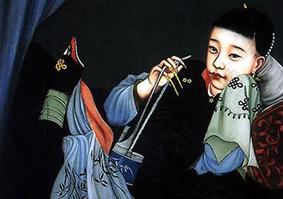|
Erotische kunst uit China
The Kunsthal Rotterdam is staging a survey of Chinese erotic
art this September. Forbidden in China. these rare works come
from the private collection of Dutchman Ferry Bertholet. who
brought them back from his Asian travels. The 500 exhibits range
from paintings and drawings to extremely rare paintings on glass.
exquisitely worked opium pipes and attributes for binding women's
feet. a significant ritual in Chinese lovemaking.
Rooted in Antiquity. erotic art is an important aspect of Chinas
cultural heritage. Its heyday was in the late Ming period, at
the beginning of the seventeenth century. Leading Chinese artists
have contributed to the genre. Although the paintings and drawings.
some of them captioned. were made under the pretext of providing
instruction for shy or inexperienced young people. their prime
function is clearly sexual arousal. Even so. Chinese erotica
do more than just titillate - they are a source of great aesthetic
pleasure too. Beauty and harmony are paramount, and supplementary
details have a deeper symbolic meaning: the lotus blossom, for
instance. stands for purity and a gnarled tree-trunk for health
and longevity.

Spring Palace Paintings
The Chinese erotic paintings and drawings are known as 'Spring
Palace Paintings'. The word 'Spring' refers to the archaic springtime
rituals during which girls and boys. separated by a brook, sang
love-songs to each other. Later, when love-making had become
part of refined imperial court culture. the word 'palace' was
added as an allusion to the emperors residence. Erotic art developed
concurrently with the rise of the rich mercantile cities of southern
China from the 10th century on. Suchow. Hangchow and Quangchow
were among the most sophisticated places in the world. The golden
age of Chinese erotic art coincided with the end of the Ming
period (1368-1644). when a relative liberal policy promoted the
development of art and science. The quality of the works rose
sharply. and artists began to sign their pictures. Later periods
often harked back to this heyday.
The Bertholet collection
After graduating from art school, Ferdinand M. Bertholet (Amsterdam
1952) traveled extensively in Asia. During one of his journeys
he came across an album of Chinese erotic pictures at a Hong
Kong antique dealer's. He was struck by the subtly romantic expression
and the harmonious compositions and colour schemes. and began
to actively collect high-quality erotic art and porcelains. Despite
the strict censorship exercised by the Chinese regime. he managed
to amass a large number of pieces. The result is the biggest
collection of Chinese erotica in the western world. comprising
works dating from the Ming period to the Fourth of May Movement
of 1919.
|
